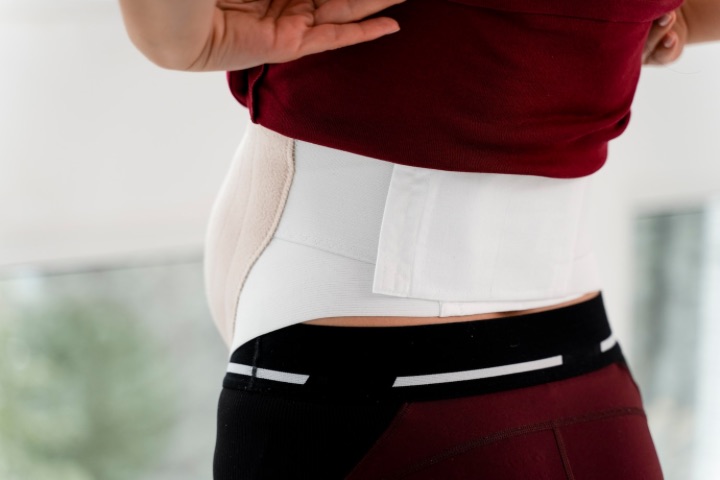Rectus diastasis, also known as abdominal separation, is a common condition that affects many people. It occurs when the two halves of the rectus abdominis muscles in the abdomen separate, causing a gap between them. Although the condition is more common in women during and after pregnancy, it can affect anyone regardless of age or gender.
The causes of rectus diastasis can vary, including pregnancy, obesity, weightlifting, and chronic coughing. Some of the symptoms of the condition include a visible bulge or doming in the abdomen, lower back pain, and difficulty with physical activities.
Fortunately, there are several treatment options available for rectus diastasis. These include exercises to strengthen the abdominal muscles, abdominal support devices such as binders and splints, and surgery in severe cases. With the right treatment, most people are able to overcome the symptoms and live a normal, healthy life.
Rectus diastasis, or abdominal separation, is a common condition that occurs when the two bands of abdominal muscles separate, causing a visible bulge in the midsection. While anyone can experience rectus diastasis, it is particularly prevalent in women during and after pregnancy.
During pregnancy, the growing uterus can place significant pressure on the abdominal muscles, causing them to stretch and separate. Additionally, hormonal changes during pregnancy can soften the connective tissue in the abdominal muscles, making them more prone to separation.

Photo Credit: Drazen Zigic
Postpartum, the abdominal muscles may take time to heal and regain their strength, particularly if the woman had a difficult labor or delivery. Other risk factors for rectus diastasis include multiple pregnancies, carrying twins or multiples, and excessive weight gain during pregnancy.
The good news is that rectus diastasis can often be treated with non-invasive methods, particularly if caught early. Women experiencing rectus diastasis during pregnancy can benefit from exercises to strengthen the abdominal muscles and improve core stability. Postpartum, physical therapy or other exercises, such as Pilates and yoga, can help to retrain weakened or damaged muscles.
Surgery may be necessary to repair the separation for more severe cases of rectus diastasis. This is particularly true if the woman is experiencing pain or discomfort as a result of the condition.
Exercises that promote core strength and stability can be especially beneficial for women with rectus diastasis. Planks, bird dogs, and glute bridges are all exercises that can help to engage the abdominal muscles without putting undue strain on the midsection. Women should avoid exercises that involve crunching or sit-ups, which can worsen the separation.
A physical therapist can work with women to develop a customized exercise program that is tailored to their individual needs and abilities. Physical therapy can help to retrain the muscles, improve core strength, and address any imbalances or weaknesses that may be contributing to the separation.
If non-invasive methods are not effective, surgery may be necessary to repair the separation. During surgery, the abdominal muscles are repositioned and sutured together. This procedure may be combined with other surgeries, such as a tummy tuck or scar tissue removal from a previous C-section.
While rectus diastasis can be a challenging condition, especially for women during and after pregnancy, there are many treatment options available. By working with a healthcare professional and engaging in exercises that promote core strength and stability, women can often successfully manage this condition and improve their abdominal health.

Photo Credit: standret
If you have been diagnosed with rectus diastasis, there are various exercises you can do to strengthen your abdominal muscles and reduce the severity of the condition. It’s important to note that these exercises should be performed under the guidance of a healthcare professional who is trained in treating diastasis recti.
Some of the most effective exercises for diastasis recti are those that target the abdominal muscles. These exercises can help to strengthen the rectus abdominis, as well as the obliques and transverse abdominis. Examples of exercises that you may be able to perform include:
In addition to exercises that target the abdominal muscles, it’s also important to incorporate exercises that promote core strength and stability. These exercises can help to support your spine and improve your posture. Examples of exercises that you may be able to perform include:
In addition to exercises, you may also benefit from using abdominal support devices, such as binders and splints. These devices can help to provide additional support to your abdominal muscles and aid in the healing process. However, it’s important to note that these devices should be used under the guidance of a healthcare professional who is trained in treating diastasis recti.

Photo Credit: Freepik
By incorporating these exercises and devices into your routine, you may be able to reduce the severity of rectus diastasis and improve your overall abdominal strength and stability.
If other treatments for rectus diastasis have not been successful in improving the condition, surgery may be an option. Surgery for diastasis recti is intended to bring the separated abdominal muscles back together and create a more toned appearance in the abdomen.
There are a few different types of surgery that may be used to address rectus diastasis. One common option is diastasis recti repair, which involves sewing the separated muscles back together. This surgery may be done either with an open incision or with laparoscopy.
In some cases, rectus diastasis may be accompanied by scar tissue from previous C-sections. If this is the case, surgery to address the scar tissue may also be necessary. This may be done as part of a diastasis recti repair surgery, or as a separate procedure.
As with any surgery, there are risks and benefits associated with diastasis recti surgery that should be carefully considered before deciding to proceed. Some potential risks include infection, bleeding, and nerve damage. Additionally, there is a risk that the muscles may separate again after surgery.
However, there are also many potential benefits to diastasis recti surgery. Successful surgery can improve the appearance of the abdomen, reduce pain and discomfort, and improve core strength and stability.
It is important to discuss the risks and benefits of diastasis recti surgery with a qualified healthcare provider before deciding whether or not to proceed with the procedure.
Rectus diastasis can have an impact on pelvic floor health, leading to symptoms such as pelvic girdle pain, back pain, pelvic organ prolapse, and urinary incontinence. The abdominal wall and the pelvic floor work together to support the body’s core, and when there is a separation in the abdominal muscles, it can cause the pelvic floor to weaken and become dysfunctional.
Pelvic floor dysfunction is common in those with rectus diastasis, and it can affect both men and women. Pelvic floor dysfunction can cause urinary or faecal incontinence, pelvic pain, and sexual dysfunction. It occurs when the pelvic floor muscles are weakened or too tight, leading to bladder and bowel control issues, pain during sex, and discomfort in the pelvic region.

Photo Credit: Freepik
For those with rectus diastasis, pelvic floor dysfunction can be exacerbated by abdominal exercises that place pressure on the pelvic floor, such as crunches or planks. It’s important to work with a pelvic floor physical therapist to develop an exercise plan that is safe and effective for those with rectus diastasis.
Pelvic floor physical therapy can be an effective treatment for those with rectus diastasis and pelvic floor dysfunction. Physical therapists use a variety of techniques to improve pelvic floor muscle function, including manual therapy, biofeedback, pelvic floor exercises, and relaxation techniques. The goal of pelvic floor physical therapy is to restore proper muscle function, eliminate pain, and improve quality of life.
In addition to pelvic floor physical therapy, there are other treatments available to help improve pelvic floor health, such as using vaginal weights or pelvic floor stimulators. It’s important to speak with a healthcare professional about the best treatment options for your specific needs.
In some cases, rectus diastasis and pelvic floor dysfunction can be prevented or minimized through lifestyle changes. Maintaining proper posture, avoiding heavy lifting, and practicing pelvic floor exercises can all help to support the pelvic floor muscles and prevent dysfunction. It’s also important to avoid exercises or activities that place excessive pressure on the abdominal muscles, such as sit-ups or heavy lifting, as these can exacerbate rectus diastasis and pelvic floor dysfunction.
If you are pregnant or planning to become pregnant, it’s important to be aware of the potential for rectus diastasis and pelvic floor dysfunction. Working with a healthcare professional and a pelvic floor physical therapist can help to prevent and manage these conditions during pregnancy and postpartum.
Rectus diastasis can be a confusing and frustrating condition, and it’s natural to have questions about it. Here are some of the most commonly asked questions about diastasis recti:
Yes, in some cases, diastasis recti can lead to an abdominal hernia. It’s important to consult with a healthcare provider if you suspect you have an abdominal hernia, as it may require medical attention.
Avoiding exercises that put additional pressure on the abdominal muscles, such as sit-ups or crunches, can help prevent further separation of the rectus abdominis muscles. Instead, focus on exercises that promote core stability and strengthen the abdominal muscles without exacerbating the separation.
Abdominal binders and wraps can be helpful in providing support to the abdominal muscles and reducing discomfort, as long as they are used correctly. It’s important to consult with a healthcare provider before using any abdominal support devices, as they may not be appropriate for everyone.
Yes, in some cases, diastasis recti can cause back pain. The weakened abdominal muscles can put additional strain on the back muscles, leading to discomfort. Pelvic floor physical therapy and exercises that target the transverse abdominis muscle can help alleviate back pain associated with diastasis recti.